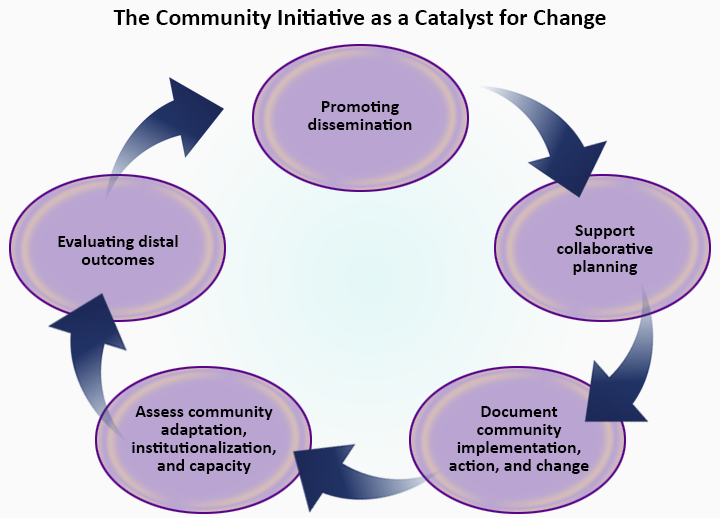Tools: Logic Model - Evaluating Comprehensive Community Initiatives

1. Supporting Collaborative Planning
Collaborative planning is a critical and ongoing task of a successful organization. It brings together people and organizations with different experiences and resources. Together, they clarify or develop the group's vision, mission, objectives, strategies, and action steps. In doing so, they can bring about changes in the community.
Support activities related to collaborative planning include the following:
A. Assess local concerns and assets
- Conducting Public Forums and Listening Sessions
- Analyzing Community Problems
- Conducting Focus Groups
- Conducting Needs Assessment Surveys
- Identifying Community Assets and Resources
- Conducting Concerns Surveys
- Conducting Interviews
- Rating Community Goals
B. Obtain data on behavior and community-level indicators
- Collecting Information About the Problem
- Developing Baseline Measures of Behavior
- Gathering and Using Community-Level Indicators
C. Facilitate setting vision, mission, objectives, and strategies
D. Help develop the action plan
2. Documenting Community Implementation, Action, and Change
Community evaluation documents what gets done by community initiatives, and lets all of the members of the initiative know about these changes. That way, community members can improve on what they have done. Community implementation, action, and change include the following related documentation activities. After each activity, relevant Community Tool Box sections are listed.
A. Monitor and provide feedback on community action and change
B. Monitor and provide feedback on implementation of key components
3. Assessing Community Adaptation, Institutionalization, and Capacity
Community evaluators also look at how the interventions are changed, and whether or not these adjustments fit the community actually work. They also determine if efforts to sustain the initiative are effective. Finally, evaluators try to measure if efforts to improve the community's capacity to address current (and future) issues have been effective. Related Community Tool Box sections include:
- Adapting Community Interventions for Different Cultures and Communities
- Planning for Long-Term Institutionalization
- Our Model of Practice: Building Capacity for Community and System Change
4. Evaluating More Distal Outcomes
Of course, the ultimate goal of most community initiatives is to move the bottom line --to have fewer people contract HIV/AIDS or be victims of violence, to give two examples. To see if this has happened, community evaluators use quantitative methods. One such method is the use of behavioral surveys. For example, a teen pregnancy prevention project might survey students about reported abstinence or unprotected sexual activity. Another quantitative method is finding archival records of community-level indicators of outcomes. For example, the project above might use estimated rates of teen pregnancy for the city or county available from the health department.
They also use qualitative methods, such as interviews with participants, to better understand the meaning and value of efforts. Used together, quantitative and qualitative information weave a rich tapestry of understanding around the initiative's efforts. They are much more powerful together than either could be alone. Evaluating more distal outcomes include the following related activities. After each activity, relevant Community Tool Box sections are listed.
A. Assess community-level outcom
- Reaching your Goals: The Goal Attainment Report
- Behavioral Surveys
- Gathering and Using Community-Level Indicators
B. Collect ongoing qualitative information
- Obtaining Feedback from Constituents: What Changes are Important and Feasible
- Rating Member Satisfaction
- Constituent Survey of Outcomes: Ratings of Importance
- Conducting Interviews with Key Participants to Analyze Critical Events
5. Promoting Dissemination
Finally, evaluators help community initiatives spread the word about effectiveness to important audiences, such as community boards and grantmakers. Evaluators help provide and interpret data about what works, what makes it work, and what doesn't work. Ways to get the word out may include presentations, professional articles, workshops and training, handbooks, media reports and on the Internet.
Information on the active dissemination of the initiative and its components can be found in the following related Community Tool Box sections:



